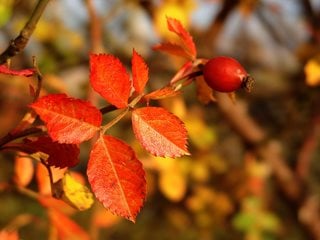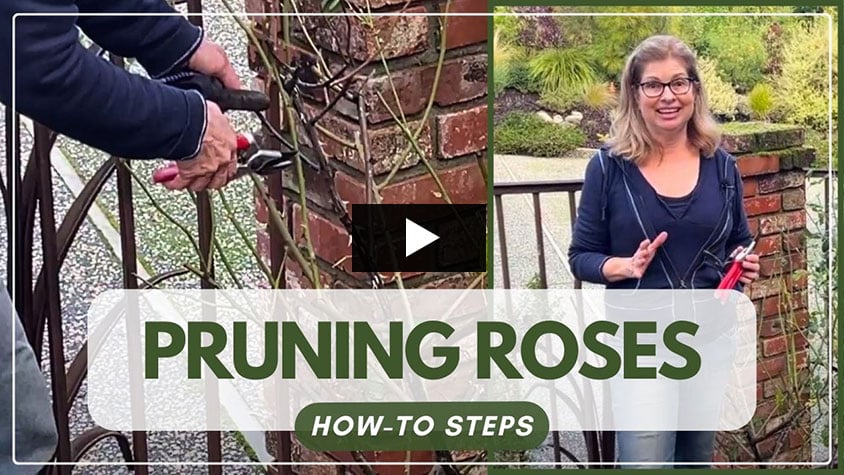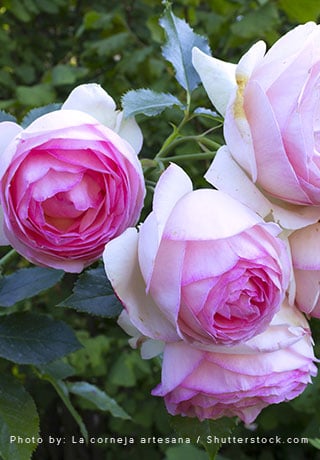Pruning Roses: 8 Steps for Healthy Rose Bushes
Learn how to trim rose bushes — it’s not as difficult as you think! Updated: 02/12/2025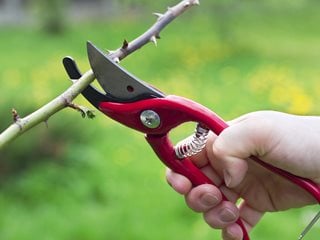
Bypass shears are ideal for pruning roses — their overlapping blades make a clean cut. Photo by: Fotoschab | Dreamstime.com.
When you know the basics of pruning roses, even inexperienced gardeners can achieve beautiful results. Don’t be intimidated by pruning—the rules and warnings are mainly for those who grow roses for specimens or exhibits. But for the casual gardener who simply wants beautiful, healthy rose bushes, there are really only a few fundamentals to follow.
WHAT YOU’LL NEED
- Good gloves — Buy on Amazon
Gauntlet-style recommended for extra protection up your forearm. - Bypass shears, not anvil — Buy on Amazon
Bypass blades overlap and make a clean cut; anvil blades meet and can crush or damage canes. - Heavy long sleeves
The right clothing will prevent getting “bit” by the thorns.
WHEN TO PRUNE ROSES
The best time to prune roses is in late winter or early spring, around the time new growth begins. This could be as early as January or as late as May, depending on your climate.
If you'd like to mark your calendar, or set yourself a pruning reminder, here are regional estimates:
- Zones 3 and 4 - May
- Zones 5, 6 and 7 - March or April
- Zone 8 - February or March
- Zone 9 - January or February
- Zone 10 - January
30-second summary
Pruning roses doesn’t have to be intimidating! In late winter or early spring, once you see new growth, grab your shears and get started. Remove any old leaves, trim away dead or weak stems, and open up the center to improve airflow. Cut canes at a 45° angle just above an outward-facing bud, then seal the cuts to prevent rot. Clean up debris to keep disease away, and don’t forget to feed your roses—they’ll reward you with healthy growth and beautiful blooms!
Spring:
Major pruning should be done in early spring, after the last frost in colder climates, by following the 8 Basic Pruning Steps below. You can also let the roses tell you — when they start to bud or leaf out, it’s time.
Summer:
Dead flowers can be cut back at any time in summer. Carl Bennett, longtime Rose Breeding Manager of David Austin Roses, says that during the flowering season, deadheading will encourage more blooms and maintain an attractive shrub.
Fall:
After the first killing frost, trim longer stems to keep them from snapping in winter storms. Keep rose bushes from being top heavy to protect them from being uprooted in strong winds. Crossing branches that could be damaged by rubbing together should also be trimmed back. Take it easy though, as too much pruning can stimulate growth, and that new growth may be damaged by freezing weather. Remove any dead or diseased branches and foliage, and clean your cutting tools well to prevent transferring disease to another plant.
JUMP TO VIDEO: PRUNING ROSES, with Rebecca Sweet
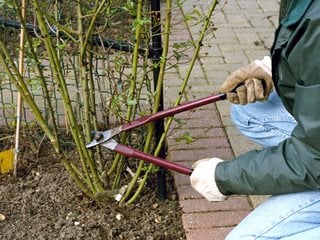
When pruning roses, your goal should be to open up the center and create a vase-like shape. Photo by: Avalon/Photoshot License / Alamy Stock Photo.
8 BASIC PRUNING STEPS
You'll be surprised to learn that modern roses don’t need as much pruning as you think. Follow these steps to ensure your roses will thrive:
1. Remove all remaining leaves.
This allows you to see the structure of the bush and clearly see all the canes (stems). This step also removes any pests or diseases that may have been hiding over winter in the foliage.
2. Start with dead wood.
How do you know its dead? Cut into it — brown is dead, green is living. Cut any dead wood back to the base.
3. Open up the center of the plant.
Take out crossing branches which can rub, causing damage and encouraging disease. The goal is to have upward-reaching branches with an open structure in a vase-like shape.
4. Remove any thin, weak growth.
The basic rule of thumb is to remove anything thinner than a pencil.
5. Prune the remaining canes.
Prune by cutting 1/4” to 1/2” above an outward-facing bud eye (a small bump found where a leaf would meet the stem). New stems grow in the direction of the bud and the goal is to encourage them to grow outward, not inward. Make cuts at a 45-degree angle sloping away from the bud, allowing water to run off.
6. Seal fresh cuts.
Protect freshly cut canes from rot and rose borers by sealing the wounds with a compound like Bonide's Garden Rich Pruning Sealer.
7. Clean up.
After pruning, make sure to clean up the surrounding area underneath. All leaves and cut branches should be disposed of as diseases and pests could be lurking. Also, sterilize your pruners by wiping them with isopropyl alcohol between plants to prevent spreading contaminants or disease.
8. Feed your roses.
Roses are “big eaters” and need proper nutrition, so feed them with a long-lasting fertilizer like Jobe's Organics Fertilizer Spikes.
HATE PRUNING, BUT LOVE ROSES?
If the steps above sound daunting, you don't have to forgo growing roses. Landscape roses are a simple way to add lots of color to your garden. Unlike hybrid teas, these resilient plants don’t require precise pruning or other care.
Pruning landscape roses is easy: come spring, cut out any old or dead wood and then trim the whole plant back by about half its height. That’s it! No need to be fussy with these vigorous, easy-going varieties.
PRUNING FAQS
Pruning height:
Prune to the height you want your rose bush to be, keeping a fairly consistent height throughout. If it is in the back of a border, leave it a little higher; for the front of a border, trim lower. For hybrid teas in particular, the lower you prune, the bigger the flower and longer the stem — good for cutting and exhibiting. Leave them a little taller and you will tend to get more blooms, although smaller and on shorter stems.
Climbing roses:
Most of the same rules apply to climbing roses but there are a few differences, mainly the way that climbers grow. Climbing roses have 2 types of canes, main and lateral. The main canes come directly from the base, and lateral canes that produce the flowers. Pruning the lateral canes can also encourage blooming. There’s no need to fuss about pruning to the outward-facing buds, as shaping climbing roses in this way is unnecessary. Lateral canes can be pruned anytime of the year to keep the climber in shape. For more information, see: Pruning Climbing Roses.
Knock Out Roses:
Just like climbing roses, pruning rules for Knock Outs are similar, but with a few exceptions. Knock Outs are generally ready for their first pruning in their second or third season, after reaching a mature height of 3-4 feet. The timing of pruning is the same as other roses, in late winter or early spring when buds start to form. Knock Outs bloom on new growth, so old, dead, or broken canes should be the first to go, cutting them back to the base. Overall, Knock Outs can be taken back by about 1/3 of their height, keeping in mind overall finished shape. Knock Outs tend to grow in phases (bloom - rest - bloom). If a mid-season trim is in order, it is best done following a blooming period while in the resting phase. Deadheading will also help to stimulate new bloom clusters and overall growth. Knock Outs tend to produce a lot of rose hips that inhibit flowering (triggering dormancy), so trimming these off will keep your Knock Out blooming.
Rose hips:
In warmer climates, leave rose hips (the small, round, orange or red fruit produced after pollination of the flowers) on through the fall and winter; they tell the rose it’s time for dormancy. So instead of deadheading the last blooms of the season, simply remove the petals, allowing the rose hips to form. In colder climates, roses are naturally triggered to go dormant, but in warmer climates they may need this nudge.
Pruning is vital to the health of the rose bush, it helps prevent disease by removing areas that may harbor infestations and also encourages flowering. Your roses may look stark after a good pruning, but roses grow very prolifically and will fill in quickly. It’s almost impossible to kill a rose bush by over-pruning. Following these few simple rules will ensure your roses are happy, healthy, and will provide you with a season of beautiful blossoms.
Video: Pruning Roses: How-To Steps
Watch Rebecca Sweet demonstrate her technique for pruning roses.

